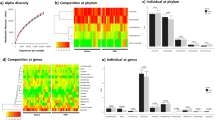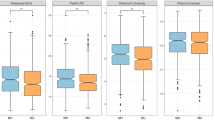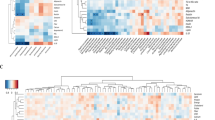Abstract
Background/objectives
High salt intake has been linked to several diseases including obesity and an increased risk of death; however, fecal salinity and the ability of salt to alter the gut microbiota, which was recently identified as an instrumental factor for health and disease, remains poorly explored.
Methods/subjects
We analyzed the fecal samples of 1326 human individuals for salinity by refractometry, 572 for gut microbiota by culturomics, and 164 by 16S rRNA-targeted metagenomics. Geographical origin, age, gender, and obesity were tested as predictors of fecal salinity and halophilic diversity. All halophilic isolates were characterized by taxonogenomics and their genome sequenced.
Results
Fecal salinity was associated with obesity independently of geographical origin, gender, and age. The first 2 human-associated halophilic archaeal members were isolated along with 64 distinct halophilic species, including 21 new species and 41 known in the environment but not in humans. No halophiles grow in less than 1.5% salinity. Above this threshold, the richness of the halophilic microbiota was correlated with fecal salinity (r = 0.58, p < 0.0001). 16S metagenomics linked high fecal salinity to decreased diversity (linear regression, p < .035) and a depletion in anti-obesity Akkermansia muciniphila and Bifidobacterium, specifically B. longum and B. adolescentis. Genomics analysis suggested that halophilic microbes are not only transient passengers but may be residents of the human gut.
Conclusions
High salt levels are associated with alteration of the gut microbial ecosystem and halophilic microbiota, as discovered during this study. Further studies should clarify if the gut microbiota alterations associated with high salt levels and the human halophilic microbiota could be causally related to human disease, such as obesity.
This is a preview of subscription content, access via your institution
Access options
Subscribe to this journal
Receive 12 print issues and online access
$259.00 per year
only $21.58 per issue
Buy this article
- Purchase on Springer Link
- Instant access to full article PDF
Prices may be subject to local taxes which are calculated during checkout



Similar content being viewed by others
References
Kotchen TA, Cowley AW Jr., Frohlich ED. Salt in health and disease—a delicate balance. N Engl J Med. 2013;368:1229–37.
Hoffmann IS, Cubeddu LX. Salt and the metabolic syndrome. Nutr Metab Cardiovasc Dis. 2009;19:123–8.
Ma Y, He FJ, MacGregor GA. High salt intake: independent risk factor for obesity? Hypertension. 2015;66:843–9.
Joossens JV, Hill MJ, Elliott P, Stamler R, Lesaffre E, Dyer A, et al. Dietary salt, nitrate and stomach cancer mortality in 24 countries. European Cancer Prevention (ECP) and the INTERSALT Cooperative Research Group. Int J Epidemiol. 1996;25:494–504.
Yang Q, Liu T, Kuklina EV, Flanders WD, Hong Y, Gillespie C, et al. Sodium and potassium intake and mortality among US adults: prospective data from the Third National Health and Nutrition Examination Survey. Arch Intern Med. 2011;171:1183–91.
Erdem Y, Arici M, Altun B, Turgan C, Sindel S, Erbay B, et al. The relationship between hypertension and salt intake in Turkish population: SALTURK study. Blood Press. 2010;19:313–8.
Brown AD. Microbial water stress. Bacteriol Rev. 1976;40:803–46.
Joossens JV, Kesteloot H. Trends in systolic blood pressure, 24-hour sodium excretion, and stroke mortality in the elderly in Belgium. Am J Med. 1991;90:5S–11S.
Baud G, Daoudi M, Hubert T, Raverdy V, Pigeyre M, Hervieux E, et al. Bile diversion in Roux-en-Y gastric bypass modulates sodium-dependent glucose intestinal uptake. Cell Metab. 2016;23:547–53.
Wilck N, Olesen S, Matus M, Balogh A, Dechend R, Alm E, et al. A high-salt diet alters the composition of intestinal microbiota in mice. Hypertension. 2014;64:A321.
Wang C, Huang Z, Yu K, Ding R, Ye K, Dai C, et al. High-salt diet has a certain impact on protein digestion and gut microbiota: A sequencing and proteome combined study. Front Microbiol. 2017;8:1838.
Miranda PM, De Palma G, Serkis V, Lu J, Louis-Auguste MP, McCarville JL, et al. High salt diet exacerbates colitis in mice by decreasing Lactobacillus levels and butyrate production. Microbiome. 2018;6:57.
Wilck N, Matus MG, Kearney SM, Olesen SW, Forslund K, Bartolomaeus H, et al. Salt-responsive gut commensal modulates TH17 axis and disease. Nature. 2017;551:585–9.
Million M, Angelakis E, Maraninchi M, Henry M, Giorgi R, Valero R, et al. Correlation between body mass index and gut concentrations of Lactobacillus reuteri, Bifidobacterium animalis, Methanobrevibacter smithii and Escherichia coli. Int J Obes. 2013;37:1460–6.
Million M, Maraninchi M, Henry M, Armougom F, Richet H, Carrieri P, et al. Obesity-associated gut microbiota is enriched in Lactobacillus reuteri and depleted in Bifidobacterium animalis and Methanobrevibacter smithii. Int J Obes. 2012;36:817–25.
Aguiar SLF, Miranda MCG, Guimaraes MAF, Santiago HC, Queiroz CP, Cunha PDS, et al. High-salt diet induces IL-17-dependent gut inflammation and exacerbates colitis in mice. Front Immunol. 2017;8:1969.
Million M, Angelakis E, Paul M, Armougom F, Leibovici L, Raoult D. Comparative meta-analysis of the effect of Lactobacillus species on weight gain in humans and animals. Microb Pathog. 2012;53:100–8.
Oxley AP, Lanfranconi MP, Wurdemann D, Ott S, Schreiber S, McGenity TJ, et al. Halophilic archaea in the human intestinal mucosa. Environ Microbiol. 2010;12:2398–410.
Lagier JC, Khelaifia S, Alou MT, Ndongo S, Dione N, Hugon P, et al. Culture of previously uncultured members of the human gut microbiota by culturomics. Nat Microbiol. 2016;1:16203.
Everard A, Belzer C, Geurts L, Ouwerkerk JP, Druart C, Bindels LB, et al. Cross-talk between Akkermansia muciniphila and intestinal epithelium controls diet-induced obesity. Proc Natl Acad Sci USA. 2013;110:9066–71.
Schneeberger M, Everard A, Gomez-Valades AG, Matamoros S, Ramirez S, Delzenne NM, et al. Akkermansia muciniphila inversely correlates with the onset of inflammation, altered adipose tissue metabolism and metabolic disorders during obesity in mice. Sci Rep. 2015;5:16643.
Angelakis E, Armougom F, Million M, Raoult D. The relationship between gut microbiota and weight gain in humans. Future Microbiol. 2012;7:91–109.
DasSarma S, DasSarma P. Halophiles. Chichester, UK: John Wiley & Sons; 2012.
Ma Y, Galinski EA, Grant WD, Oren A, Ventosa A. Halophiles 2010: life in saline environments. Appl Environ Microbiol. 2010;76:6971–81.
Seng P, Rolain JM, Fournier PE, La SB, Drancourt M, Raoult D. MALDI-TOF-mass spectrometry applications in clinical microbiology. FutureMicrobiol. 2010;5:1733–54.
Drancourt M, Bollet C, Carlioz A, Martelin R, Gayral JP, Raoult D. 16S ribosomal DNA sequence analysis of a large collection of environmental and clinical unidentifiable bacterial isolates. J Clin Microbiol. 2000;38:3623–30.
Million M, Tidjani AM, Khelaifia S, Bachar D, Lagier JC, Dione N, et al. Increased gut redox and depletion of anaerobic and methanogenic prokaryotes in severe acute malnutrition. Sci Rep. 2016;6:26051.
Caporaso JG, Kuczynski J, Stombaugh J, Bittinger K, Bushman FD, Costello EK, et al. QIIME allows analysis of high-throughput community sequencing data. Nat Methods. 2010;7:335–6.
Quast C, Pruesse E, Yilmaz P, Gerken J, Schweer T, Yarza P, et al. The SILVA ribosomal RNA gene database project: improved data processing and web-based tools. Nucleic Acids Res. 2013;41:D590–6.
Cavalli-Sforza LL. The DNA revolution in population genetics. Trends Genet. 1998;14:60–5.
Khelaifia S, Raoult D. Haloferax massiliensis sp. nov., the first human-associated halophilic archaea. New Microbes New Infect. 2016;12:96–8.
Angelakis E, Yasir M, Bachar D, Azhar EI, Lagier JC, Bibi F, et al. Gut microbiome and dietary patterns in different Saudi populations and monkeys. Sci Rep. 2016;6:32191.
Segata N, Izard J, Waldron L, Gevers D, Miropolsky L, Garrett WS, et al. Metagenomic biomarker discovery and explanation. Genome Biol. 2011;12:R60.
Tan TG, Sefik E, Geva-Zatorsky N, Kua L, Naskar D, Teng F, et al. Identifying species of symbiont bacteria from the human gut that, alone, can induce intestinal Th17 cells in mice. Proc Natl Acad Sci USA. 2016;113:41–E8150.
Schell MA, Karmirantzou M, Snel B, Vilanova D, Berger B, Pessi G, et al. The genome sequence of Bifidobacterium longum reflects its adaptation to the human gastrointestinal tract. Proc Natl Acad Sci USA. 2002;99:14422–7.
Lagier JC, Armougom F, Million M, Hugon P, Pagnier I, Robert C, et al. Microbial culturomics: paradigm shift in the human gut microbiome study. Clin Microbiol Infect. 2012;18:1185–93.
Lang JM, Eisen JA, Zivkovic AM. The microbes we eat: abundance and taxonomy of microbes consumed in a day’s worth of meals for three diet types. Peer J. 2014;2:e659.
Wei Y, Lu C, Chen J, Cui G, Wang L, Yu T, et al. High salt diet stimulates gut Th17 response and exacerbates TNBS-induced colitis in mice. Oncotarget. 2017;8:70–82.
Shen W, Shen M, Zhao X, Zhu H, Yang Y, Lu S, et al. Anti-obesity effect of capsaicin in mice fed with high-fat diet is associated with an increase in population of the gut bacterium Akkermansia muciniphila. Front Microbiol. 2017;8:272.
Leshem M, Saadi A, Alem N, Hendi K. Enhanced salt appetite, diet and drinking in traditional Bedouin women in the Negev. Appetite. 2008;50:71–82.
Khan MS, Sasidharan TO, Ghosh PK. Water regulation in Barmer goat of the Rajasthan desert. Experientia. 1979;35:1185–6.
Shields R, Mulholland A, Elmslie R. Action of aldosterone upon the intestinal transport of potassium, sodium, and water. Gut. 1966;7:11.
Lupan I, Ianc MB, Ochis C, Popescu O. The evidence of contaminant bacterial DNA in several commercial Taq polymerases. Rom Biotechnol Lett. 2013;18:6.
Lagier JC, Dubourg G, Million M, Cadoret F, Bilen M, Fenollar F, et al. Culturing the human microbiota and culturomics. Nat. Revi. Microbiol. 2018 In press.
Golden MH. Oedematous malnutrition. Br Med Bull. 1998;54:433–44.
Collaborators GBDO, Afshin A, Forouzanfar MH, Reitsma MB, Sur P, Estep K, et al. Health effects of overweight and obesity in 195 countries over 25 years. N Engl J Med. 2017;377:13–27.
Acknowledgements
We thank the culturomics team for excellent growing work. We wish to honor here the memory of Professor Ogobara Doumbo, who died during the revision of this paper, who was a collaborator with unequaled human and professional qualities. This work has received financial support from the French Government through the Agence Nationale pour la Recherche (ANR), including the “Programme d’Investissement d’Avenir” under the reference Méditerranée Infection 10-IAHU-03. This work was supported by Région Provence Alpes Côte d’Azur and European funding FEDER PRIMMI (Fonds Européen de Développement Régional - Plateformes de Recherche et d’Innovation Mutualisées Méditerranée Infection). We thank Magdalen Lardiere for English reviewing.
Author contributions:
E.H.S., S.K., B.S. and F.B. analysed salinity, isolated the strains, and described the new halophilic species; D.B., V.M., C.R. and A.L. performed the metagenomics sequencing and bio-informatic analyses; E.I.A., S.K., D.M., O.D. and C.S. collected samples and information from included individuals; M.M., E.I.A. and D.R. wrote the manuscript; M.S., M.M. and E.H.S. analysed the data; J.C.L. supervised the study and D.R. conceived and supervised the study.
Author information
Authors and Affiliations
Corresponding author
Ethics declarations
Conflict of interest
The authors declare that they have no conflict of interest.
Electronic supplementary material
Rights and permissions
About this article
Cite this article
Seck, E.H., Senghor, B., Merhej, V. et al. Salt in stools is associated with obesity, gut halophilic microbiota and Akkermansia muciniphila depletion in humans. Int J Obes 43, 862–871 (2019). https://doi.org/10.1038/s41366-018-0201-3
Received:
Revised:
Accepted:
Published:
Issue Date:
DOI: https://doi.org/10.1038/s41366-018-0201-3
This article is cited by
-
Mechanisms of the intestinal and urinary microbiome in kidney stone disease
Nature Reviews Urology (2022)
-
Amoxicillin impact on pathophysiology induced by short term high salt diet in mice
Scientific Reports (2022)
-
Salinity significantly affects intestinal microbiota and gene expression in striped catfish juveniles
Applied Microbiology and Biotechnology (2022)
-
Human microbiota research in Africa: a systematic review reveals gaps and priorities for future research
Microbiome (2021)
-
Genomic analysis of halophilic bacterium, Lentibacillus sp. CBA3610, derived from human feces
Gut Pathogens (2021)



